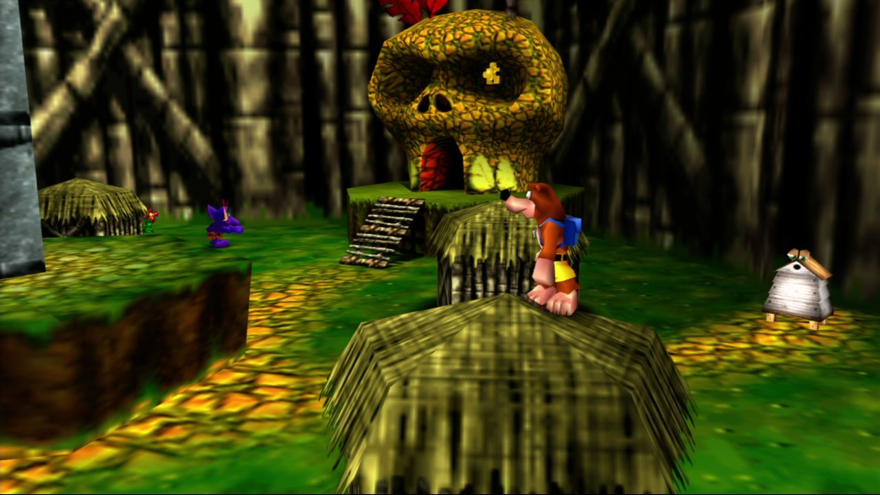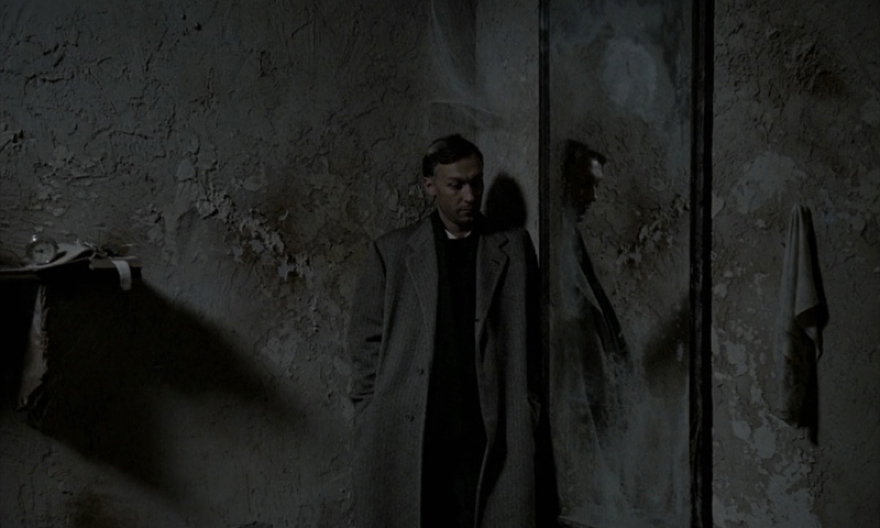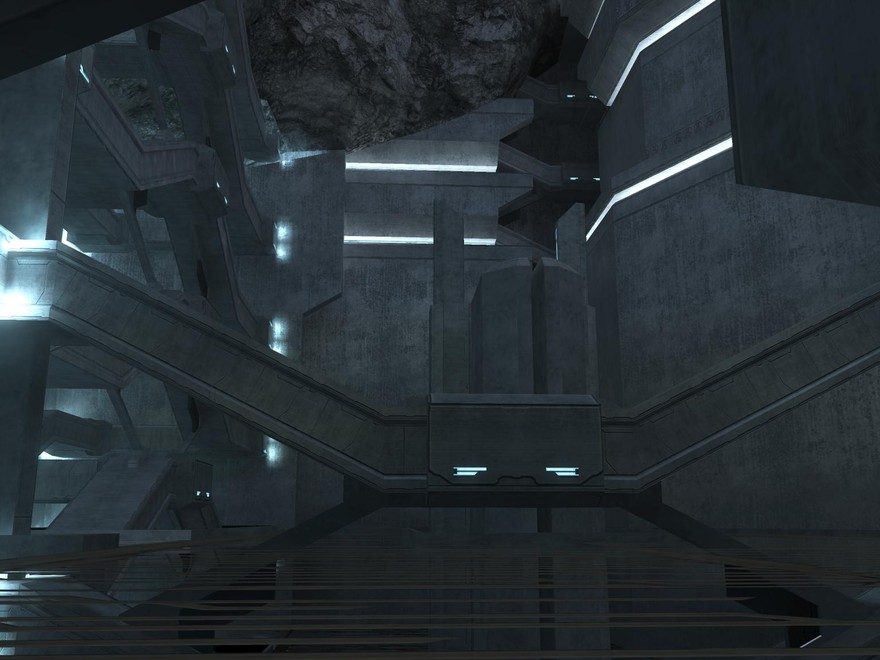In the climactic scene of Andrei Tarkovsky’s Nostalghia, a Russian poet estranged in Italy must cross a pool with a lit candle to prevent the end of the world. The poet, also named Andrei, is in Italy for research, and prior to this scene his driving motivation has been to return to his family in the pastoral Russian countryside. But in his research, he meets Domenico, a holy fool whose mystery captivates Andrei. It is Domenico who gives Andrei the candle and tells him how he must use it. Gradually, this mystery inserts itself into Andrei’s dreams of home, and he delays his return journey so he can keep his word and cross the pool. When the wind snuffs the candle’s flame, requiring Andrei to start again, more slowly, we see the conflicting doubts and beliefs in his expression.
The first time I saw this scene, I imagined how a game might express the same ideas, how a player would face the same conflict while attempting Domenico’s instructions. But what would compel the player to continue when their candle fails? What compels Andrei? This is the mystery that empowers the scene, and for that, Andrei is necessarily the viewer’s subject, not the player’s avatar whose feelings are reduced or supplanted.

Nostalghia is a film that investigates its questions through its characters, each embodying candidate answers. These are questions about meaning and happiness. Andrei believes that his homesickness or nostalgia is the source of his unhappiness. Similarly, the film shows women praying to Mary because they want to become mothers, and the elderly bathing in sulfur baths because they want to live forever. Domenico is the only character free of this search for meaning. It is for this reason that the locals call him a madman, and the same reason that Andrei senses Domenico is closer to the truth than most.
After this encounter, Andrei’s motivations change. Although the film does not specify what, something drove Andrei to Italy, away from his family. Returning may end his homesickness, but it would be treating a symptom and not the disease. Andrei’s sickness is not just longing for the place where he and his family live, but a search for home, with its resonating assurances of purpose and belonging.
Videogames as a medium can allow us to inhabit characters and worlds where other media can only describe. Within games there are the clockwork remnants of creation, and exploring a game’s edges can be an almost spiritual attempt to know its creators. When I first wondered how a game could adapt Nostalghia, I ignored the ways that games already have. The same conflicts of motivation, of doubt and belief, exist within game worlds. After all, once we have experienced all that a game’s designers intended, what keeps us playing? Why do we continue to inhabit solved worlds?
///
In 1998, Rare released Banjo-Kazooie for the Nintendo 64. In the game, the player is a bear named Banjo with a bird named Kazooie in his backpack on a quest to rescue Banjo’s sister from a witch. For the player, this means a pattern of exploring new worlds, discovering their mysteries, and collecting enough puzzle pieces to unlock the next world, where the pattern repeats. But the only interaction available to the player is to reduce a world’s complexity, solve and collect and defeat everything until the world is empty and the player must move on. Friendly characters no longer require the player’s help or have dialogue to share. They become parts of an animatronic set. This process is death to these worlds. Banjo-Kazooie’s conceit is that on saving Banjo’s sister, home will be reestablished, but in practice this is where the game ends. The promised home only exists in the fleeting purpose the player feels in each new world before they too are solved.

There is one obstacle to this inevitable advance, however. In the winter-themed “Freezeezy Peak,” in a walrus’s cave, there is a transparent wall through which the player can see another room, and in that room there is a key made of ice. There is nothing the player can do to break through the wall, and there are no hidden switches or secret entrances to access the ice key, as there are for other puzzles. There is not even a lock to suggest a use for the key. The only other time the game refers to the key is the final cutscene if the player has collected everything. This cutscene shows three secrets—the ice key and two eggs—but provides no explanation beyond hinting they will have some use in the sequel, Banjo-Tooie.
We now know that Rare intended the ice key and other secrets as part of a feature called “Stop ‘n’ Swap.” On the original Nintendo 64, the data from a game would remain in the memory for about ten seconds, which would be enough time to swap cartridges and allow the second game to read data from the first. However, by the time the sequel was released in 2000, the hardware had changed, and the ten-second window shrunk to one. Rare cut the feature and created a new ice key puzzle for the new game.

Yet the original ice key, and the bonus cutscene’s promise, kept that game’s worlds alive, and it kept its players returning. Only by hacking Banjo-Kazooie did anyone solve the puzzle. The designers left cheat codes a player can enter on the floor of a sand castle in the second world. One of these codes, “cheat now you can see a nice ice key which you can have for free,” removes the wall that prevents the player from collecting the ice key and solving the game’s last mystery.
When games yield more easily than Banjo-Kazooie, some players will extend the world’s life through role-playing or other player expression. They modify or replace the game’s definition of success with their own. Specifically, the role-player might spend time enriching the simple stories of a game and perform tasks that are not rewarded within the game worlds. Or the player might adapt or subvert the design to tell her own story. Pacifist runs are a common example of this, but even a vegetarian run adds a layer to a game’s intended experience. But these attempts to extend a game’s life amount to make-believe. Instead of bringing the player closer to the truth behind these designed worlds, they move the player in different ways, perhaps toward better self-knowledge, or perhaps only toward fantasy and escape.
By the second half of Nostalghia, Andrei wanders into a flooded ruin, drunk on vodka, and tells a passing child that the decay reminds him of home. “Here’s a story,” Andrei tells her, “A man saves another who was sinking into a slimy pond… thereby risking his own life. Now they are both lying on the edge of the pond out of breath, exhausted. The rescued man says, ‘Idiot. Why did you do that? I live in there!’” Andrei laughs. “I live in there. He took great offense.” By this scene in the film, Andrei has become cynical about his nostalgia. He knows that returning home is not the cure for his sickness. It is a pursuit of truth, a belief like Domenico’s, that drives him now.
///
In 2001, I put away my Nintendo 64 for an Xbox and Halo, a game about cyborgs fighting aliens. Unlike Banjo-Kazooie, there is no persistence between worlds, and advancing to the next only requires reaching the end alive. But at their most intricate, Halo‘s worlds are blank canvases for player expression. In some levels, the player can choose the order of objectives, but more often Halo lets her choose the method. This keeps the game interesting, but there is still only so much to experience without repetition, and after completing the game on its hardest difficulty, I turned to exploration. In cooperative mode, I would spend hours with a friend in a single level, finding ways to break the designed sequence or climb outside of designed spaces. We were searching for secrets, but we were also searching for its own sake.

On a small island world, we climbed atop the plateaus, jumping off of each other to boost to places that one player could not reach alone. We exploited the tree collision to step out of the world and watch our AI pals fight aliens without us. In a canyon level we spent hours descending a sheer-face cliff to the floor below, gripping any ledge possible and dying many times along the way, instead of crossing the bridge and facing the same dozen fights we’d fought many times before. This slow sequence break prevented enemies from spawning and doors from unlocking, but we broke through them with another glitch to continue onward to new lands.
The way Halo gave in to our exploration tantalized us. We had found intentional Easter eggs, so each new discovery simultaneously felt like we were finding truths hidden for us alone and charting new lands. The game’s designers created beautiful environments for the player to fight aliens within, but there is a stranger, deeper beauty in looking over the edge of a world, into the void where designed spaces end.
///
Banjo-Tooie, which Rare released in 2000, expanded the content and complexity of the original game. Worlds in the sequel were interconnected in strange ways, and the player needed to learn these connections to collect puzzle pieces and advance. The average puzzle in Banjo-Tooie was at least as complicated as the most difficult puzzles of the original, but the puzzle for the new ice key was only a little more complex than the new standard.
As a kid, I reached Banjo-Tooie’s later levels, “Hailfire Peaks” and “Grunty Industries,” but they were too difficult for me, and without any nostalgic pull I have not completed them as an adult either. These worlds late in the game are uninviting and ugly. There are more enemies, and some friendly characters have robotic doppelgangers who will attack when the player tries to help them. Because of this, there is none of the original game’s tension between a desire to inhabit friendly worlds and the need to continue onward. These worlds do not want you.
Despite these obstacles, I completed the revised ice key quest. Unlike the puzzles in the later levels, the designers clearly marked the sequence for the player. Inside a vault opened with the ice key is an item that lets the player change Kazooie into a dragon. The change is superficial, and it is a disappointing outcome to Banjo-Kazooie’s mystery.
But was it ever possible for the designers to prevent disappointment? In horror films, revealing the monster is always a relief to the audience, not because the monster we imagine is always scarier, but because it is not resolved to a certain form and certain capabilities. The monster loses its omnipotence and omnipresence when the film reveals it, and the terror of any specific reality pales in comparison to an infinite and amorphous unknown. Something similar is true of the ice key; I did not imagine a specific consequence of solving that mystery, but the unspecific hope was enormous.
Banjo-Tooie is not alone in this disappointment. Halo 3’s design codified the secrets of the first two games into a system that modifies a player’s score in a competitive version of the campaign. In later games, these secret score modifiers are available from the beginning. How can a secret exist when a game tells its players they have found 1 of 12, or 40 of 100? What joy is there in player expression when an achievement defines a path in advance?
///
When games force designed spaces in favor of a cinematic experience, the possibility to escape and feel the presence of any creator is more difficult. Easter eggs, and the glitches necessary to find them, can undermine the integrity of authored stories, much as an actor stumbling through lines or a boom microphone appearing on screen can weaken a film. But this integrity comes at the cost of space for the player to explore, and without that, without Andrei to cross the pool, these worlds end.
